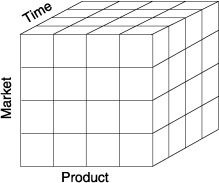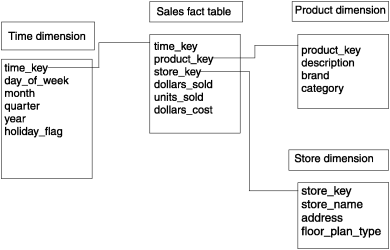
To build a dimensional database, you start with a dimensional data model. The dimensional data model provides a method for making databases simple and understandable. You can conceive of a dimensional database as a database cube of three or four dimensions where users can access a slice of the database along any of its dimensions. To create a dimensional database, you need a model that lets you visualize the data.
Suppose your business sells products in different markets and evaluates the performance over time. It is easy to conceive of this business process as a cube of data, which contains dimensions for time, products, and markets. Figure 36 shows this dimensional model. The various intersections along the lines of the cube would contain the measures of the business. The measures correspond to a particular combination of product, market, and time data.

Another name for the dimensional model is the star-join schema. The database designers use this name because the diagram for this model looks like a star with one central table around which a set of other tables are displayed. The central table is the only table in the schema with multiple joins connecting it to all the other tables. This central table is called the fact table and the other tables are called dimension tables. The dimension tables all have only a single join that attaches them to the fact table, regardless of the query. Figure 37 shows a simple dimensional model of a business that sells products in different markets and evaluates business performance over time.
